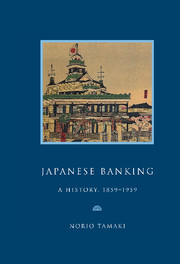Book contents
- Frontmatter
- Contents
- Preface
- Genealogy of leading Japanese banks, 1859–1959
- List of abbreviations
- Map
- Part I A bankrupt Shogunate, 1859–1868
- Part II The Meiji Restoration: monetary confusion and banking experiments, 1868–1881
- Part III Matsukata, the wizard of Japanese banking, 1881–1897; the Yokohama Specie Bank (1880) and the Bank of Japan (1882)
- Part IV The Japanese on the London money market, 1897–1911
- Part V War, the Japanese boom years, 1911–1919
- Part VI Crisis and the road to war, 1919–1937
- Historical background
- 21 Post-war collapse, 1919–1923
- 22 The 1923 catastrophic earthquake, 1927 financial disaster and the new Bank Act, 1923–1927
- 23 Financing heavy industries, 1927–1937
- 24 The challenge of militarism, and a change of roles for Nichigin and Shokin, 1929–1937
- Part VII Complete commitment, struggle and defeat, 1937–1945
- Part VIII American ‘democratisation’ and the search for growth, 1945–1959
- An extraordinary century, 1859–1959
- Appendices
- Notes
- Bibliography
- Index
24 - The challenge of militarism, and a change of roles for Nichigin and Shokin, 1929–1937
Published online by Cambridge University Press: 03 February 2010
- Frontmatter
- Contents
- Preface
- Genealogy of leading Japanese banks, 1859–1959
- List of abbreviations
- Map
- Part I A bankrupt Shogunate, 1859–1868
- Part II The Meiji Restoration: monetary confusion and banking experiments, 1868–1881
- Part III Matsukata, the wizard of Japanese banking, 1881–1897; the Yokohama Specie Bank (1880) and the Bank of Japan (1882)
- Part IV The Japanese on the London money market, 1897–1911
- Part V War, the Japanese boom years, 1911–1919
- Part VI Crisis and the road to war, 1919–1937
- Historical background
- 21 Post-war collapse, 1919–1923
- 22 The 1923 catastrophic earthquake, 1927 financial disaster and the new Bank Act, 1923–1927
- 23 Financing heavy industries, 1927–1937
- 24 The challenge of militarism, and a change of roles for Nichigin and Shokin, 1929–1937
- Part VII Complete commitment, struggle and defeat, 1937–1945
- Part VIII American ‘democratisation’ and the search for growth, 1945–1959
- An extraordinary century, 1859–1959
- Appendices
- Notes
- Bibliography
- Index
Summary
The lengthy debates on when and how to resume specie exports or to return to the full working of the gold standard resulted in a library of monetary literature, which, because of its bulk, the bank historian can only dip into. The Minister of Finance, Junnosuke Inoue, in addressing the Diet, argued that lifting the specie embargo and returning to the gold standard with the old par value of yen to pound sterling and dollar would have deflationary effects upon the economy and would lower the price level, thus enhancing Japan's international competitiveness and eventually giving strength to the economy. This unjustified ministerial optimism proved to be very damaging.
The specie embargo was lifted in January 1930 but had to be reimposed in December 1931. During these two years, the specie outflow was the worst in history, amounting to ¥417 million in 1931. All this was aggravated by rampant speculation as some banks were buying in dollars and pounds sterling especially in the autumn of 1931 when it was clear that the embargo would have to be reimposed. The specie reserve, at ¥1,343 million at the end of 1929, was reduced to ¥557 million at the end of 1931. The decrease of ¥786 million was larger than the total specie reserve in 1916. The Finance Minister, Inoue, was replaced by Korekiyo Takahashi on the very day of the reimposition of the specie embargo, which marked the final Japanese departure from the gold standard.
- Type
- Chapter
- Information
- Japanese BankingA History, 1859–1959, pp. 166 - 170Publisher: Cambridge University PressPrint publication year: 1995



